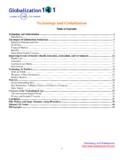Transcription of Advanced Gene Editing: CRISPR-Cas9
1 Advanced gene editing : CRISPR-Cas9 . Updated December 7, 2018. Congressional Research Service R44824. Advanced gene editing : CRISPR-Cas9 . Summary Scientists have long sought the ability to control and modify DNA the code of life. A gene editing technology known as CRISPR-Cas9 offers the potential for substantial improvement over other gene editing technologies in that it is simple to use and inexpensive and has a relatively high degree of precision and efficiency. These characteristics have led many in the scientific and business communities to assert that CRISPR-Cas9 will lead to groundbreaking advances in many fields, including agriculture, energy, ecosystem conservation, and the investigation, prevention, and treatment of diseases.
2 Over the next 5 to 10 years, the National Academy of Sciences projects a rapid increase in the scale, scope, complexity, and development rate of biotechnology products, many enabled by CRISPR-Cas9 . Concomitant with the promise of potential benefits , such advances may pose new risks and raise ethical concerns. For example, a Chinese researcher recently claimed that he had created the first genetically engineered human babies. According to the researcher, he used CRISPR-Cas9 to disable a gene that will make it harder for the twin girls, who were born in November 2018, to contract human immunodeficiency virus (HIV).
3 The as yet unsubstantiated claim has sparked outrage and ethical debates by the international scientific community and others. Prior use of CRISPR-Cas9 gene editing in human embryos was generally limited to non- viable embryos, in part, to address ethical concerns such as the fact that the genetic change would affect not only the immediate patient, but also future generations who would inherit the change. Additionally, crispr -related approaches ( gene drives) are being considered to reduce or eliminate the mosquito that serves as the primary vector for the transmission of Zika or malaria, thereby improving public health.
4 Some scientists and environmental groups have raised ethical questions and expressed concerns about the unintended ecological consequences of eliminating a species or introducing a genetically modified organism into an open environment. Some experts assert that the current system for regulating biotechnology products the Coordinated Framework for the Regulation of Biotechnology may be inadequate, with the potential to leave gaps in oversight. Regulatory gaps may lead to increased uncertainty that could affect the development of future biotechnology products or a loss of public confidence in the ability of regulators to ensure that such products are safe.
5 In the 116th Congress, policymakers may want to examine the potential benefits and risks associated with the use of CRISPR-Cas9 gene editing , including the ethical, social, and legal implications of crispr -related biotechnology products. Congress also may have a role to play with respect to regulation, research and development, and economic competitiveness associated with CRISPR-Cas9 gene editing and future biotechnology products. Congressional Research Service Advanced gene editing : CRISPR-Cas9 . Contents Introduction .. 1. Overview .. 1. What Is CRISPR-Cas9 ? .. 1. gene 2. How CRISPR-Cas9 technology Works.
6 2. What Are gene Drives? .. 3. CRISPR-Cas9 Market Projections, Investments, and R&D Spending .. 4. Market Projections .. 4. Private Investments .. 5. Federal R&D Funding and Scientific Publications .. 8. The Coordinated Framework for the Regulation of Biotechnology .. 9. Application Areas and Issues for 11. Human Health and Medicine .. 12. Diabetes .. 12. Malaria .. 12. Sickle Cell Disease .. 13. Duchenne Muscular Dystrophy .. 13. Antibiotic Resistance .. 14. Biomedical and Clinical Research: Heritable Versus Non-Heritable Changes .. 14. Regulation and Oversight of Biomedical and Clinical Research.
7 17. Ethical Considerations .. 19. Agricultural Development .. 21. Regulation and Oversight of Agricultural Biotechnology .. 22. Social Acceptance and Ethical Concerns .. 25. CRISPR-Cas9 and International Agriculture .. 25. Industrial Biotechnology .. 27. Ecosystem Management and 27. gene Drives and Environmental Concerns .. 28. Regulation and Oversight of gene Drives .. 28. Social Acceptance and Ethical Concerns .. 30. International Regulation of Genetically Modified Organisms .. 32. Basic Research .. 33. National Security 34. Figures Figure 1. CRISPR-Cas9 gene editing technology .. 3. Figure 2.
8 How a gene Drive Works .. 4. Tables Table 1. NIH Funding for crispr -Related Research, FY2011-FY2018 .. 8. Table 2. Number of crispr -Related Scientific Publications, 2011-2018 .. 9. Congressional Research Service Advanced gene editing : CRISPR-Cas9 . Contacts Author 35. Congressional Research Service Advanced gene editing : CRISPR-Cas9 . Introduction Genes, the fundamental code of life, are written in DNA (deoxyribonucleic acid). Before DNA. was even discovered, humans sought to manipulate genes through selective breeding. Since its discovery, scientists, science fiction writers, philosophers, and others have speculated on the implications of being able to modify DNA.
9 Over the last half century, billions of dollars and immeasurable effort have been devoted to understanding, characterizing, and controlling DNA. This report describes a gene editing technology , known as CRISPR-Cas9 , with the potential to revolutionize genetic engineering and the biotechnology industry. The report then provides information on the potential economic benefits of the technology and identifies some issues for congressional consideration, including the regulation of current and future products, national security concerns, and ethical and societal issues surrounding the use of the technology .
10 Overview What Is CRISPR-Cas9 ? CRISPR-Cas9 is a gene editing technology that offers the potential for substantial improvement over other gene editing technologies1 in ease of use, speed, efficacy, and cost. These characteristics led Science magazine to name CRISPR-Cas9 gene editing technology Breakthrough of the Year in Many in the scientific, engineering, and business communities believe that CRISPR-Cas9 may offer revolutionary advances in the investigation, prevention, and treatment of diseases; understanding of gene function; improving crop yields and developing new varieties; production of chemicals used in biofuels, adhesives, and fragrances.













